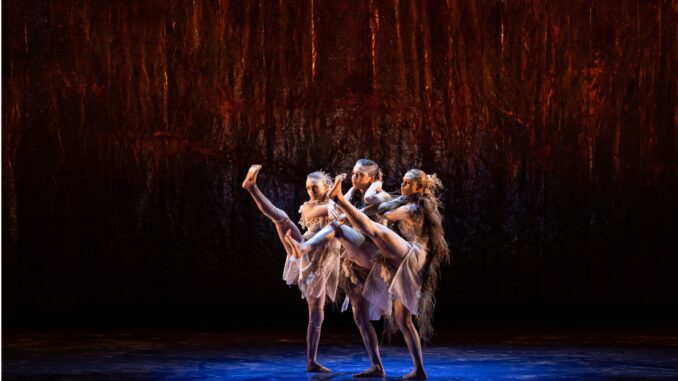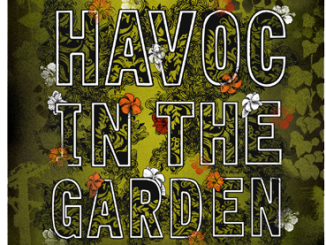
Aboriginal and Torres Strait Islander readers are advised that this review contains the name of someone who has passed away. Aboriginal and Torres Strait Islander viewers of the work are also warned that SandSong contains images and voices of deceased persons.
A shimmering, molten backdrop – gold and red like the surface of the sun or a crucible of red hot precious metal – stretches the full width and height of the ASB Waterfront Theatre Auditorium. This is only one of many images SandSong sears into the mind of the viewer.
Evoking the unfathomable scale and beauty of the Kimberley and Great Sandy Desert regions (a combined area of 700,000 square kilometres) SandSong was created by Bangarra Dance Theatre in consultation with Wangkatjungka and Walmajarri Elders. The work tells their stories and shares their knowledge in four acts, traversing both the cultural disruption and physical displacement Aboriginal people have experienced, and offering visions of Indigenous futures.
The work was prompted by Bangarra collaborator Ningali Josie Lawford-Wolf, a Wangkatjungka woman. Lawford-Wolf had suggested making a work inspired by the Kimberley in 2019 but sadly passed away later that year. SandSong honours her memory and draws on the knowledge of her siblings Putuparri Tom Lawford and Eva Nargoodah who took on roles as cultural advisors.
The divisions of the four acts reflect seasonal and historical shifts. Act 1 is titled ‘Makurra, Cold Dry Season’ and shows life in the Kimberley before Wangkatjungka and Walmajarri people were forced off the land and foreshadows the arrival of white colonists; Act 2 ‘Parranga, Hot Dry Season’ shows change occurring and a dust storm brewing; Act 3 ‘Kartiya’ (meaning White Person) starts with the recording of an auctioneer, a harsh interruption of the land and people, and depicts time spent on the stations before a climatic walk off and return to the desert; and Act 4 ‘Yitilal, Wet Season’ shows healing, demonstrating that even this intergenerational trauma cannot break the cycle.
Across the acts traditional dances are presented as well as original choreography (Stephen Page and Francis Rings). Elements of the movement vocabulary were new to me. In places the foot and then the leg leads as if the rest of the body is auxiliary to the leg rather than the leg being periphery to the central torso (as the limb largely appears in Western contemporary dance). The experience, for a viewer without knowledge of traditional Aboriginal and Torres Strait Islander dance practices, or a familiarity with contemporary dances practices as established by NAISDA Dance College (National Aboriginal Islander Skills Development Association), or even Bangarra’s wider oeuvre, is akin to the challenge of listening to a language you only know a handful of words from. Meaning is conveyed, but you know the beauty of the sentence structure eludes you.
However, this is not alienating, it is instead a revelatory experience. Anything that might be missed in terms of the history conveyed is offered in extensive programme notes. And, even if you did not have the insight of the programme, the music driving the performance (scored by composer Steve Francis and interwoven with a range of recorded voices and traditional songs) provides emotive cues clear enough to bridge the cultural divides.
Over the course of the performance the light falling on that glittering gold backdrop shifts and it becomes gleaming black blue rock. Another lighting change and somehow it appears to be a wall of flame or dust roaring through a distant tree line. It is astonishingly beautiful and speaks to the sublime quality of all of the elements of this production.
Bangarra Dance Theatre clearly deserve their reputation as one of the most distinctive theatrical voices in the Australian performing arts industry. SandSong is a work that burns on in the mind’s eye well after the final bows have been taken.
SandSong played the ASB Waterfront Theatre 15th to the 18th of March 2023 as part of the Auckland Art Festival



Leave a Reply